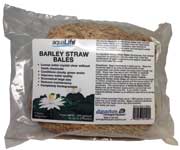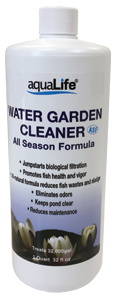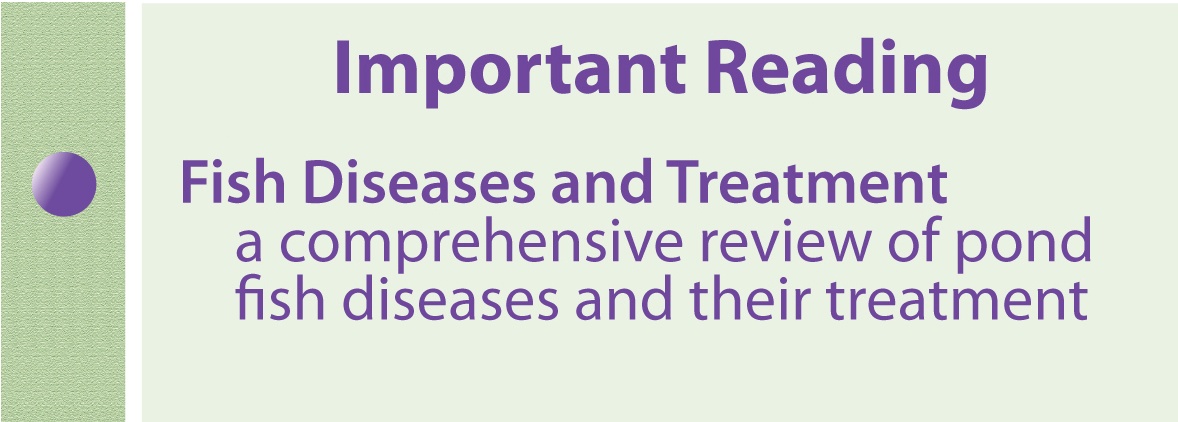15. Conditioning Your Pond
There are variety of different products used to treat and condition your pond. Conditioning your pond creates a healthy pond atmosphere is just as important as maintaining one, and choosing the best products makes a world of difference.
AquaLife Complete Water Conditioner
• Promotes healing
• Replaces slime coat
• Removes chlorine, ammonia, and chloramines
• Detoxifies nitrite and heavy metals
• Adds essential electrolytes
• Boosts alkalinity
• Works instantly
AquaLife Complete Water Conditioner, 4oz
AquaLife Complete, 16oz
AquaLife Complete, 1 gallon
AquaLife Complete Water Conditioner, 5 gallons

AquaLife Complete is a great product to condition your pond by preparing the tap water and rendering it healthy for both fish and plants. You can create healthy, crystal clear and fish-friendly pond water. It should be used with the first filling. This product binds metal ions and protects your pond animals against chlorine and other environmental pollutants.

AquaLife Barley Extract

• All natural, safe and effective pond water clarity management
• Unique formulation includes barley straw extract and beneficial bacterial
• Does not deplete dissolved oxygen
• Non-toxic, safe for all aquatic life, humans and pets
• Biodegradable and eco-friendly
AquaLife Barley Extract 16oz
AquaLife Barley Extract 32oz
AquaLife Barley Extract 1 gallon
AquaLife Barley Extract supplies both beneficial compounds derived from barley straw and billions of natural pond bacteria to help keep pond water clear all season long.
We produce our all-natural liquid formulation for AquaLife Barley Extract by a proprietary fermentation process using only barley straw.
AquaLife Barley Extract is the only product on the market that provides over 200 billion live beneficial pond bacteria in every gallon. It is a true 2-in-1 formula, unlike anything else, and its dual action keeps pond water clear, conditioning your pond than any other product.

AquaLife Barley Straw Bales, 2 pack
Barley straw does not kill existing algae, but it inhibits the new growth of algae. The exact mechanism is poorly understood, but it seems that barley straw, when exposed to sunlight and in the presence of oxygen, produces a natural chemical that inhibits algae growth.
Barley straw does not hinder the growth of other aquatic plants. In fact, in some cases aquatic plant growth has increased after barley straw applications because algae are no longer present to compete with the aquatic plants for nutrients.
Barley straw is most effective when applied early in the year prior to the appearance of algae (fall through early spring). When applied to cold water (less than 50°F), it may take six to eight weeks for the straw to begin releasing the active chemicals to inhibit algae growth.

AquaLife Water Garden Cleaner ASF

- Contains 5 species of beneficial pond bacteria that are important for conditioning your pond
- Reduces maintenance
- All-natural formula of beneficial pond and aquarium bacteria
- Eliminates fish wastes, excess fish food, toxic ammonia and nitrite, problem-causing nitrate and phosphate, and odors
- Use year-round in koi ponds
- Reduces the need for water changes by biologically cleaning the gravel and clearing water – week after week, month after month.
AquaLife Water Garden Cleaner ASF, 32oz
AquaLife Water Garden Cleaner, 1gal


PUMPS & WATER FEATURES
Aside from conditioning your pond, water movement, fountains, waterfalls, filtration, and water features can make the difference between the swamp in the backyard and the ultimate gardening experience. All pond water should be circulated every 1-6 hours through biological filtration.
See Pond Filters
See Choosing a Pump

TO CALCULATE POND CAPACITY: You should know the approximate capacity of your pond for the addition of fish, water conditioners and medications.
Rectangular Ponds
1. Multiply length by width by depth (in feet) to obtain volume in cubic feet.
2. Multiply this figure by 7.5 to give the pond capacity in gallons.
Example: Your pond is 12’ long by 10’ wide and is 2’ deep. 12’ long X 10” wide X 2’ deep = 240 cubic feet in pond. Then, 240 cubic feet X 7.5 = 1,800 gallons.
Circular Ponds
1. Multiply depth in feet by the square of the radius in feet, then multiply this figure by 3.14 to give cubic feet.
2. Next, multiply this number by 7.5 to give the pond’s approximate capacity in gallons.
Example: Your circular pond is 2’ deep and 10’ across. 2’ deep X (5’ X 5’) x 3.14 = 157 cubic feet. Then, 157 cubic feet x 7.5 = 1177.5 gallon.
The Timed Volume Method
Timed Volume is the most accurate method of measuring pond volume and is especially helpful in determining the volume of irregularly shaped pools, as well as circular and rectangular pools. You’ll need a manageable container of known volume, such as a 5 gallon bucket and a garden hose.
- With the hose turned on full flow, fill the bucket and record the time to fill it. You may want to repeat this a couple of times to make sure your timing is accurate.
- Fill the pond with the hose on full flow and record the amount of time required to fill it. Now, you’re ready to calculate the volume.
- Make sure all the units of time are the same – minutes is most convenient. If the bucket takes 1/2 a minute to fill, the time is .5 minutes. If the pond takes 3 hours to fill, your time converted to minutes is 180. Divide the time to fill the pond by the time to fill the bucket, then multiply that number by the gallons in the container. This number is the number of gallons in the pond. In this example, the final pond volume is 1800 gallons.



